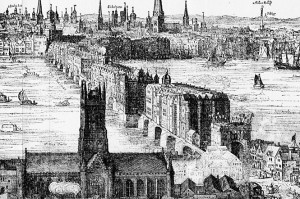 Thank you to Jen for inspiring this post. She emailed me yesterday with the question “Was Anne Boleyn’s head put on a spike” and it’s one that I’m often asked about Anne Boleyn and also her brother and the men who were executed in May 1536, and I know it’s a question I will be asked today. The answer is “no, it wasn’t” and I’m so glad that their remains were treated with respect, rather than being put on show.
Thank you to Jen for inspiring this post. She emailed me yesterday with the question “Was Anne Boleyn’s head put on a spike” and it’s one that I’m often asked about Anne Boleyn and also her brother and the men who were executed in May 1536, and I know it’s a question I will be asked today. The answer is “no, it wasn’t” and I’m so glad that their remains were treated with respect, rather than being put on show.
Traitors’ (or alleged traitors’) heads were often displayed on spikes (or pikes) on London Bridge as a warning to the population. In his Travels in England during the reign of Queen Elizabeth Paul Hentzner, a German man who visited London in 1598, described London Bridge and said “Upon this is built a tower, on whose top the heads of such as have been executed for high treason are placed on iron spikes: we counted above thirty.”1
Sir Thomas More’s head was displayed there, although his daughter Margaret Roper “bribed the executioner, whose office it was to remove the heads, and obtained possession of the sacred relic”,2 and the heads of Thomas Culpeper and Francis Dereham were displayed there after their executions in December 1541. It is said that Dereham and Culpeper’s heads were still there when Catherine Howard was taken to the Tower of London by boat in February 1542. If you click on the image above, which is from an engraving by Claes Visscher showing Old London Bridge in 1616, you can see what look like flags on the arched gatehouse on the bottom right. They’re not flags, they’re heads!
But what about the the heads of Anne Boleyn, George Boleyn, Henry Norris, William Brereton, Francis Weston and Mark Smeaton?
We know that their heads were not put on display because of what the primary souces state about their burials. Here are some examples of evidence:
- Charles Wriothesley, chronicler and Windsor Herald – Wriothesley wrote of the men: “Their bodies with their heades were buried within the Tower of London; the Lord of Rochfordes bodie and head within the chappell of the Tower, Mr. Weston and Norys in the church yeard of the same in one grave, Mr. Bruton and Markes in another grave in the same churche yerde within the Tower of London.”3
Regarding Anne Boleyn’s burial, Wriothesley wrote “her bodye with the head was buried in the Chappell within the Tower of London, in the queere [quire] there, the same daye at afternoone, when she had reygned as Queene three yeares, lackinge 14 dayes, from her coronation to her death.”4 - Letters and Papers – In a document from the Vienna Archives, transcribed in Letters and Papers, it says of Anne’s remains: “Immediately the executioner did his office; and when her head was off it was taken by a young lady and covered with a white cloth. Afterwards the body was taken by the other ladies, and the whole carried into the church nearest to the Tower of London.”5
- Lancelot de Carles – In his Poème sur la Mort d’Anne Boleyn, Lancelot de Carles writes:
“The head and body were taken by the ladies,
Who were judged to be nearly dead themselves,
From languor and extreme weakness
But fearing for their mistress
To be held and touched by the unworthy
Hands of cold-blooded men,
They offered themselves to this task,
And this dead body was carried by the nearly dead,
Wrapped in a white blanket,
Up to the place of sad burial,
Inside the Tower, where she had been a prisoner
Which would also be her final resting place.”6 - Holinshed’s Chronicle – In the account of Anne Boleyn’s execution in Raphael Holinshed’s Chronicle, it says “hir bodie with the heade was buried in the queere of the chapell in the tower.” Regarding the men, it says “the lord Rochfords bodie with the head was buried in the chappell of the tower, the other foure in the churchyard there.”7
So, there are various mentions of their heads being buried with their bodies and I have been unable to find any mention of their heads being displayed on London Bridge. I’m so relieved!
Notes and Sources
- Hentzner, Paul Travels in England during the reign of Queen Elizabeth (London: Cassell, 1892) read at http://www.visionofbritain.org.uk/text/chap_page.jsp?t_id=Hentzner&c_id=1
- E.E. Reynolds quoted in “Lady Margaret Roper and the head of Sir Thomas More” at http://www.lynsted-society.co.uk/Library/Books/Margaret_Roper_and_head_of_Sir_Thomas_More.html
- Wriothesley, Charles. A Chronicle of England During the Reigns of the Tudors, from A.D. 1485 to 1559, 42.
- Ibid., 40.
- Letters and Papers, Foreign and Domestic, Henry VIII, Volume 10, 911.
- Lancelot de Carles in La Grande Bretagne devant L’Opinion Française depuis la Guerre de Cent Ans jusqu’a la Fin du XVI Siècle, George Ascoli. This translation is from “Anne Boleyn, Lancelot de Carle, and the Uses of Documentary Evidence”, Susan Walters Schmid, dissertation Arizona State University 2009, p174.
- Holinshed, Raphael. Chronicles of England, Scotland and Ireland, Volume III, 797.